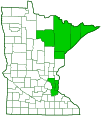Blue Tooth
(Hydnellum caeruleum)
Conservation • Description • Habitat • Ecology • Distribution • Taxonomy
Conservation Status |
|
|||||||
| IUCN Red List | not listed |
|||||||
| NatureServe | NNR - Unranked |
|||||||
| Minnesota | not listed |
|||||||
Description |
||
Blue Tooth is a medium-sized to large tooth fungus. It occurs in Europe, in Asia, in Central America, and throughout North America. It is widespread but uncommon in the United States. It is found in woodlands in the summer and fall, alone or in groups but not clustered. It grows on the ground mostly under conifers, but in California and on the Gulf Coast it also grows under live oak and other hardwoods. It is mycorrhizal, obtaining its nutrients from the rootlets of a tree while facilitating greater absorption of nutrients from the soil by the tree. The cap on young mushrooms is top-shaped and white or pale tan usually with a bluish tint. It usually grows alone but is sometimes fused with other caps. The surface is soft, felty or velvety, and often has needles or leaves incorporated into it. As it matures it flattens out, sometimes becoming depressed in the middle. Mature caps are 13⁄16″ to 5⅞″ (3 to 15 cm) wide. The velvety coating disappears in the center exposing a light to dark brown surface while the still growing margins remain felty and white or bluish. The margin bruises blue. Older caps are pitted. The underside of the cap, the pore surface, is covered with short, tooth-like spines. The spines are ⅛″ to ¼″ (3 to 6 mm) long and whitish or or grayish, sometimes tinged with blue when young. As they age they turn brown to dark brown with pale tips. The pore surface runs down the stalk. The stalk is short, thick, and usually covered with dirt and debris. It is ¾″ to 2″ (2 to 5 cm) long, ⅜″ to 13⁄16″ (1 to 3 cm) thick, and orangish-brown. The flesh has two layers, a spongy upper (outer) layer and a tough and fibrous inner core. In the cap the flesh has bluish, grayish, and brown zones. In the stalk it is orangish-brown or rust-colored. It is not poisonous but is mealy and considered inedible. The spore print is brown. |
||
Similar Species |
||
Habitat and Hosts |
||
On the ground under conifers |
||
Ecology |
||
Season |
||
Summer and fall |
||
Distribution |
||||
|
Sources |
|||
| 6/6/2022 | ||||
Occurrence |
||||
Widespread but not common |
||||
Taxonomy |
|||
| Kingdom | Fungi (Fungi) | ||
| Subkingdom | Dikarya | ||
| Phylum | Basidiomycota (Basidiomycete Fungi) | ||
| Subphylum | Agaricomycotina (Higher Basidiomycetes) | ||
| Class | Agaricomycetes (Mushrooms, Bracket Fungi, Puffballs, and Allies) | ||
Order |
Thelephorales | ||
Family |
Bankeraceae | ||
Genus |
Hydnellum | ||
Synonyms |
|||
|
|||
Common Names |
|||
Blue Tooth Blue-Gray Hydnellum Blue-Green Hydnellum |
|||
Glossary
Mycorrhizal
A symbiotic, usually beneficial relationship between a fungus and the tiny rootlets of a plant, usually a tree.
Visitor Photos |
|||||
Share your photo of this fungus. |
|||||
| This button not working for you? Simply email us at info@MinnesotaSeasons.com. Attach one or more photos and, if you like, a caption. |
|||||
Brooke Roegge |
|||||
 |
 |
||||
 |
 |
||||
MinnesotaSeasons.com Photos |
|||||
|
|||||

Slideshows |
||

Visitor Videos |
|||
Share your video of this fungus. |
|||
| This button not working for you? Simply email us at info@MinnesotaSeasons.com. Attach a video, a YouTube link, or a cloud storage link. |
|||
Other Videos |
|||

Created: 8/3/2020
Last Updated:



